The information in this article applies to:

QUESTION
I have a number of different architectural design styles that I often use and would rather not have to set up my default settings every time I begin a new plan that will use one of these styles. How can I do this work once and save it for future use?
ANSWER
In Chief Architect, any time you open a new, blank plan, its initial default settings are copied from a template. You can create your own custom template plans to reflect the architectural styles and materials that you use most often.
A template plan is essentially a blank plan with default settings customized to meet a particular set of design needs. You may find it helpful to create more than one template, each set up to draw a particular architectural style. It's a good idea to save all your templates in a particular location, such as a folder in Documents or in the Chief Architect Templates directory.
If migrating forward to the current version of Chief Architect from an older version, please make sure to follow the instructions in the Migration Guide located in your Digital Locker.
While it's a good idea to go through all of the defaults to make sure the template is setup exactly how you need it, there are some defaults that are more critical to change ahead of time, as they can be troublesome to change after the design is complete. It's recommended that these "Critical Defaults" are set up in the template and reviewed before starting any plan.
Begin by selecting File> New Plan  from the menu to open a new, blank plan using the default plan template.
from the menu to open a new, blank plan using the default plan template.
Critical Defaults:
All default settings are important. It's always a good idea to form a habit of setting the defaults for an item prior to placing them in the plan.
You can also set up layer sets in your template file. A layer set consists of a complete list of the layers in the current plan or layout along with the display settings for each layer as set for a particular type of view or purpose. These display settings can be modified and can be different for each layer set. Please see the Related Articles section below for more more information on layer sets.
Saving:
Floor and Ceiling Structure Defaults
The floor and ceiling Structure defaults consist of the layers that make up the floor and ceiling platforms. For example the floor joists and sheathing or the ceiling joists. This is also where the Floor and ceiling finishes are set.
- Select Edit> Default Settings
 from the menu to open the Default Settings dialog.
from the menu to open the Default Settings dialog.
- Expand the list for Floors and Rooms, select Floor/Ceiling Platform, and click Edit.
- In the Floor/Ceiling Platform Defaults dialog, choose which platform settings to modify and then click the Edit button.
-
Ceiling Structure typically contains just a layer for ceiling joists
-
Ceiling Finish typically contains a layer for the drywall and a layer for the paint color.
-
Floor Finish typically contains a layer for the floor finish as well as any layers for underlayment.
-
Floor Structure typically contains a layer for the floor sheathing and a layer for the floor joists.
- In this example, the Floor Structure Edit button is clicked and in the Floor Structure Definition dialog, the Layers, Materials, Energy Values, Structure properties, and a diagram of the floor structure is displayed.
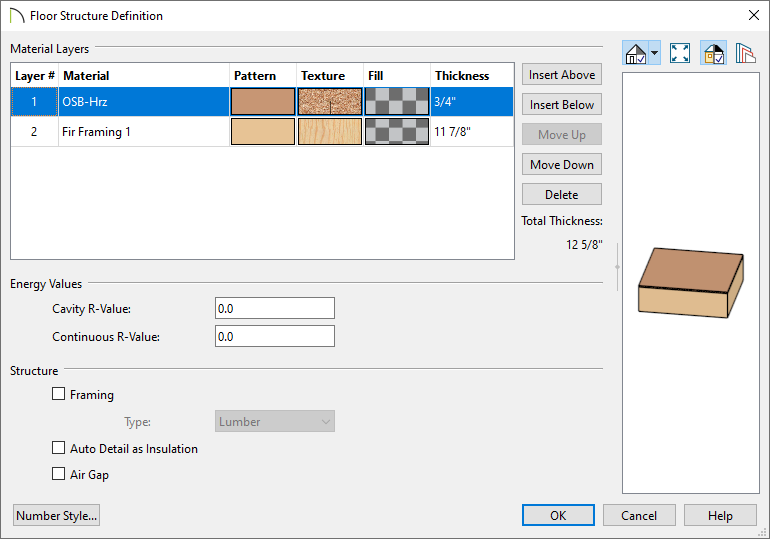
- Layers are numbered and listed from the top of the structure to its bottom.
- To select a layer for editing, click on the layer to highlight it, and then click once again in the box you'd like to modify.
For example, if you're wanting to change the material of a layer to something different, click on the material name for a selected layer. In the image above, you would want to click on the words: OSB-Hrz. To adjust the thickness, click on the 3/4" value specified for Layer #1.
- Use the Insert Above/Below buttons to add additional layers, use the Move Up/Down buttons to move layers up or down, and use the Delete button to delete selected layers.
- Specify the Energy Values of the selected Floor or Ceiling Structure if desired.
- Specify the structure’s Cavity R-Value, which is the R-value of its cavity insulator: most commonly, the insulation between wood or metal joists.
- Specify the Continuous R-Value, which is the R-value of continuous insulators such as rigid foam sheets.
- Specify whether the selected layer has special structural attributes.
- Check Framing to produce framing in the selected layer when framing is generated for the selected structural assembly's type.
- Select the framing Type from the drop-down list.
- Check Auto Detail as Insulation to generate Insulation boxes in the selected layer when Auto Detail
 is used in cross section views.
is used in cross section views.
- Check Air Gap to prevent the selected layer from displaying in 3D views or being calculated in the Materials List.
- Once all desired changes have been made, click OK.
Floor and Ceiling Height Defaults
Many important default values that affect rooms are specified in the Floor Defaults dialog for each floor in a plan. This dialog controls important information that the program uses to create a 3D model - particularly floor and ceiling heights and materials. Moldings can also be specified in the Floor Defaults dialog.
Only the defaults for the first floor of a building can be set ahead of time. The program uses the setting form the first floor to create subsequent floors. When a new floor is created, its floor defaults are displayed and can be changed at that time.
- Select Edit> Default Settings
 from the menu to open the Default Settings dialog.
from the menu to open the Default Settings dialog.
-
Expand the list for Floors and Rooms, expand Floor Levels, click on 1st Floor, and then click Edit.
- On the Structure panel of the 1st Floor Defaults dialog, specify the default Ceiling height for Floor 1.
- Ceiling and Rough Ceiling represent framing dimensions from the bottom of the wall bottom plate to the top of the wall top plate.
- The default Floor Height for Floor 1 is set at 0".
- Finished Ceiling represents the dimension between the the floor finish and the ceiling finish.
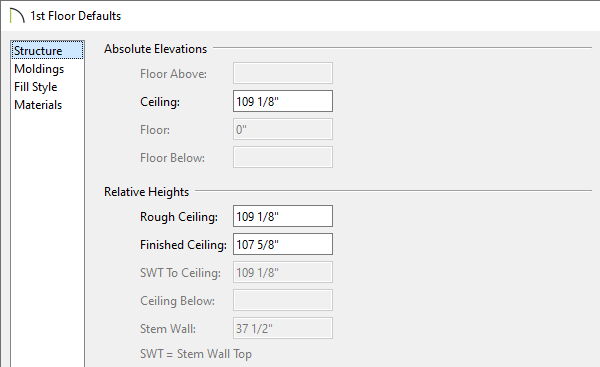
At the bottom of the Structure panel, there is a setting for Monolithic Slab Foundation. If a foundation plan is desired, do NOT put a check in this setting. Instead, choose Monolithic Slab in the Build Foundation dialog or the Foundation Defaults prior to building the foundation. If Monolithic Slab Foundation is checked, the current Floor Structure will be replaced by a single 4" (100mm) layer of concrete with footings that can be seen in camera views only.
- On the Moldings panel:
- The default template will have one molding already setup for Base Molding.
- If you want to remove the molding, choose Delete.
- If you want to add additional moldings, Click on Add New.
- If you want to replace the existing molding with a new one, choose Replace.
- If you click on Add New or Replace, the Select Library Objects dialog will appear where you can then browse to find a molding profile that meets your needs.
- Specify the Width and Height, the Type, along with other related properties if desired.

- When you are satisfied with your selections, click OK.
Framing Defaults
The Framing Defaults dialog allows you to specify several properties relating to floor, ceiling, wall, and roof framing components, including such things as spacing, joist widths, framing materials, and plate values. Properties for beams, posts, roof trusses, along with door and window openings can also be setup here.
- Select Edit> Default Settings
 from the menu to open the Default Settings dialog.
from the menu to open the Default Settings dialog.
- Select Framing and click the Edit button.
- On the Foundation panel of the Framing Defaults dialog, specify the Spacing and Width listed for the Subfloor for Floor 1
- On the 1st panel specify the Spacing and Width for the Ceiling Above Floor 1 as well as the Subfloor for Floor 2
Notice that the Floor Structure and Ceiling Structure matches what is specified in the Floor/Ceiling Platform Defaults section specified earlier.
- Specify your desired settings for the additional framing defaults located in this dialog, and then click OK.
Wall Type Defaults
The settings in the various wall defaults dialogs determine what wall types are drawn when using the different wall tools. It's import to become familiar with these settings and how they related to your style of building.
- Select Edit> Default Settings
 from the menu to open the Default Settings dialog.
from the menu to open the Default Settings dialog.
- Expand the list for Walls, select Exterior Wall, and then click the Edit button.
- In the Wall Defaults dialog that displays, click on the Wall Types panel and specify the desired wall type to be used when using this particular wall tool.
- Click the Define button if you would like to create or modify a custom wall type in the Wall Type Definitions dialog.
For more information on customizing or creating a new wall type, please see the Related Articles section below.
- In addition to specifying structural aspects of a wall, such as its framing and sheathing, you can specify siding material such as lap siding, shingles or stucco and interior materials including paneling, finished tongue and groove, and sheetrock.
- Repeat steps 2 and 3 to define the defaults for Interior Wall, Foundation Wall, Pony Wall, as well as any other other Wall tools.
Dimension Defaults
There are several saved dimension defaults. Having multiple defaults allows you to switch between them to have the dimensions change their behavior when you're dimensioning for different views. For example, you can have dimensions location the framing layer of the walls for your framing plans and the interior surface of the walls for your interior design plans. Another example would be specifying a different sized text style for your plot plan versus a smaller sized text style for interior elevations.
- Select Edit> Default Settings
 from the menu to open the Default Settings dialog.
from the menu to open the Default Settings dialog.
- Expand the list for Dimension, select Dimensions, and click the Edit button.
- In the Saved Dimension Defaults dialog that opens, the active dimension default is highlighted in the list as well as being specified at the bottom of the dialog.
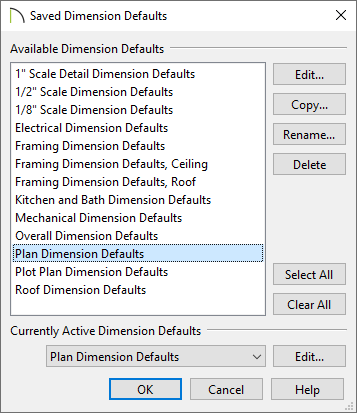
- Select the default that needs to change and then click Edit to open the saved default. Review these setting to verify that they meet the needs of your projects.
- Access each of the Locate... panels to specify which objects you want dimensions to locate when using the various Dimension tools.
- Specify the desired Format on the Primary Format panel.
- Specify the desired Text Style on the Text Style panel.
- Repeat Step 4 for all Dimension Defaults in the template.
Saving the Template
Once the default settings for a file are setup to your liking, it's a good idea to save it as a template to be used for future plans.
- Select File> Templates> Save As Template
 .
.
- A dialog will appear allowing you to delete any elements that could have come from an existing plan file. At the bottom you can select the checkbox to set this template as the default for imperial (or metric) plans. Click OK.
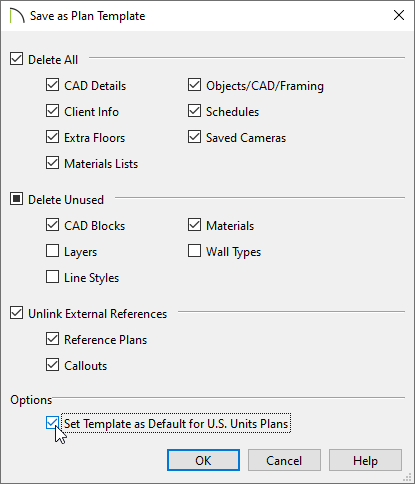
- Give the new template a short, descriptive name, then click Save.
The Chief Architect Templates folder is the default file location when choosing the "Save As Template" option. If you'd like to change the file location in which you save this to, you can do so prior to clicking Save.
- To choose a different template when creating a new plan, select File> Templates> New Plan from Template
 , select the template from the list, then click OK.
, select the template from the list, then click OK.
Setting the Default Template
Access the Preferences dialog to set the default template for when the New Plan or New Layout action/tool is selected.
- Select Edit> Preferences
 from the menu if you're on a Windows PC or Chief Architect> Preferences
from the menu if you're on a Windows PC or Chief Architect> Preferences  if you're on a Mac.
if you're on a Mac.
- On the New Plans panel of the Preferences dialog, click the Browse button to the right of the Plan Template text field for your unit of measurement.
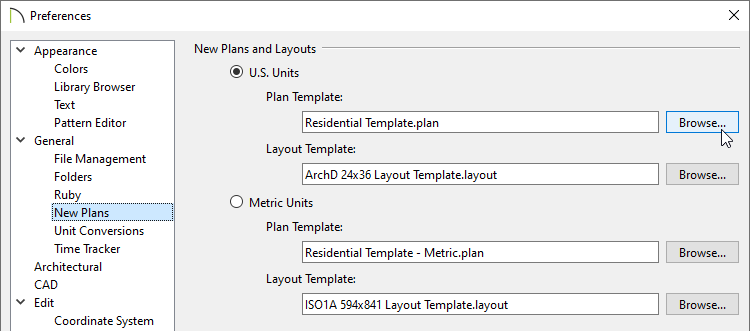
- In the Select a Plan Template File dialog, browse to the location of your new template file and click Open to specify this file as your plan template.
- Click OK to close the dialog and apply your change.

 from the menu to open a new, blank plan using the default plan template.
from the menu to open a new, blank plan using the default plan template. from the menu to open the Default Settings dialog.
from the menu to open the Default Settings dialog.
 from the menu to open the Default Settings dialog.
from the menu to open the Default Settings dialog. 

 from the menu to open the Default Settings dialog.
from the menu to open the Default Settings dialog.  from the menu to open the Default Settings dialog.
from the menu to open the Default Settings dialog. from the menu to open the Default Settings dialog.
from the menu to open the Default Settings dialog.
 .
. 
 , select the template from the list, then click OK.
, select the template from the list, then click OK. from the menu if you're on a Windows PC or Chief Architect> Preferences
from the menu if you're on a Windows PC or Chief Architect> Preferences  if you're on a Mac.
if you're on a Mac.